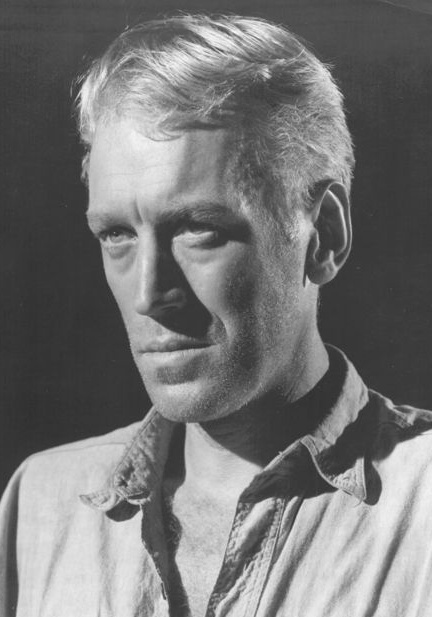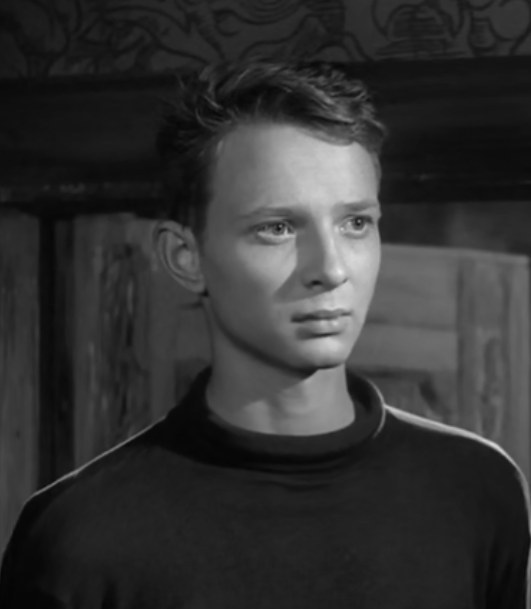犹在镜中 Såsom i en spegel(1961)

又名: 对镜猜谜(港) / 穿过黑暗的玻璃(台) / 在黑暗中穿过镜子 / Through a Glass Darkly
导演: 英格玛·伯格曼
编剧: 英格玛·伯格曼
主演: 哈里特·安德森 古纳尔·布约恩施特兰德 马克斯·冯·叙多夫 拉尔斯·帕斯高
类型: 剧情
制片国家/地区: 瑞典
上映日期: 1961-10-16(瑞典)
片长: 89分钟 IMDb: tt0055499 豆瓣评分:8.3 下载地址:迅雷下载
简介:
- 遗传了母亲精神病的凯伦(Harriet Andersson 饰)经过入院治疗,被作家父亲大卫(Gunnar Björnstrand 饰)安排到一小岛上调养。凯伦男友马丁(Max von Sydow 饰)是一名医生,两人的感情此时处于低谷,马丁相信凯伦有痊愈的可能。青春期中的弟弟米纳斯颇有才华,但看上去有些焦躁。四人在封闭的岛上休整,但各自心中的不安似乎正慢慢滋长。凯伦发现父亲在冷漠的观察自己病情变化后情绪短暂失控。次日上午马丁与大卫乘小舟离去,被留下的凯伦开始沉溺于冥想,并对米纳斯显示出侵略性,在两人回岛之前凯伦昏倒在破旧的木船内,她向弟弟宣称,自己听到了上帝的声音……
演员:
影评:
- 在伯格曼和他的第一任妻子结婚之后,其电影风格走向了室内化。在我看来,这种电影风格的变化,混合早期的文学化对白,由此形成了最典型的伯格曼风格(有些评论家称之为“室内心理剧”)。在这风格最大的转折期,伯格曼拍摄了震惊世界的“上帝沉默三部曲”——《犹在镜中》《冬之光》《沉默》。这三部曲真正体现了导演对于神学的怀疑态度,从某种角度来讲,《第七封印》和《处女泉》并没有彻彻底底的否定上帝的概念,《第七封印》中的马戏演员看到的圣母形象,以及《处女泉》最后的神迹出现,都是对上帝的肯定。然而,《犹在镜中》中对上帝存在的怀疑,《冬之光》中对信念的否定,以及在《沉默》中,对上帝缺失情况下的人与人关系的讨论,不仅否定了上帝概念,同时流露了伯格曼后期的电影风格(人物交流困境和心理阴影)。
《犹在镜中》中讲述了一个患有精神疾病的女儿和她的丈夫、父亲、弟弟和上帝之间的关系。故事主要发生在一个小岛上的与世隔绝的小屋里。对于这个女人来说,她一直在等待着上帝的接待(这被看作一种精神疾病),上帝不仅成为了她心灵上的寄托和追求,同时可以在生理上给予性满足(当然这也被看作某种精神分裂的特征)。而电影结尾上帝以蜘蛛向女人显现最终导致了她精神的完全崩溃。此外,父亲对于女儿的病情并不是特别的关心,他细心的纪录病情的发展只是为了自己写作的需要,女儿的精神失常同他的妻子的自杀好像是一种生命轮回,一种对于他冷漠虚伪的犬儒主义极大的抨击。而她的丈夫只想按照自己的意愿来治疗自己的妻子,他是人类迷信科学的典型代表,因此夫妻两人不可能有任何沟通的信念基础。在整个故事中,最具特征的人物还有弟弟一角,他正处在青春萌动的年纪,对于神秘而美丽的姐姐有一种暧昧的需求,然而由于道德的心理原因,他又对于这带给他冲动的女性抱有一种敌对的态度,他们相互辱骂(在姐姐看到他在拉丁文书中偷藏女人的图片),又相互吸引(姐姐在她的阁楼中向他诉说自己的痛苦)。在电影最后,姐姐被直升飞机带走之后,弟弟在心理上也留下了很深的阴影,他所构建起来的现实生活也因此瓦解。电影结尾,父子一段对话,父亲试图规避上帝存在的问题,将爱作为一种信仰灌输给已经丧失信仰能力儿子。最后一句对白“父亲和我说话了”,也可以看作是整部充满了压抑、挣扎、绝望的电影中一个希望和曙光式的缓和。 - 周四晚,世界哲学日,中大哲学系自然也呼应着搞个哲学周。学术明星刘小枫老师却借此机会劝告大家远离哲学,特别是以迪卡尔数理逻辑为支撑、康德以降的西方启蒙哲学,说那是危及性命的,大意是因为康德把后来者拉入一个用数理逻辑求证“灵魂是否存在”的死胡同里。很多聪明人在胡同深处穷其一生不得其解,杨绛在忧伤中,沉浸到翻译柏拉图对话录《斐多》中;德里达、拉康、福柯们则在死胡同深处又凿出一些更深更死的叫做结构主义、后现代主义、解构主义、超现实主义、新结构主义、超新后存在主义等死胡同;尼采烦不得了,不和那些哲学家玩了;陀思妥耶夫斯基想不通了,也干脆放弃。
试图用思辩甚至量化的方法追问灵魂,注定不得其解,甚至危及性命,以上那些人在胡同底或许可以看到一面墙,墙上投影着苏格拉底的最后一天,苏格拉底最终也为此追问丢了名。
所以,刘小枫庆幸自己“有信仰,有诗为伴”,不会把脑筋用在那危及性命的无极追问上。并最终以此番辩驳和教育,为他所从事的宗教学与诗学研究确立正当性,整个讲座结构和他的书作一样,严谨、工整、证据充分、最后绕回出发点后自圆其说。
以上,也是我这个哲学、宗教学、诗学门外汉对那个“反哲学夜”的初浅感悟。
次日晚,我继续远离八卦本行,重新分裂回艺术电影怀抱,开看伯格曼“沉默三部曲”(其实,我的伯格曼启蒙,甚至艺术电影启蒙,都源自大三误入昆明电影学习小组初期的一次放映活动,《冬日之光》),按顺序,当然是《犹在镜中》。
这下发现,伯格曼只在那追问灵魂和上帝是否存在的小胡同里走了一小会——最远到了那口《处女泉》,其间和死神下了盘棋《第七封印》——就完全从胡同里退出,拒绝任何寻找上帝存在的努力。于是,他也没被追问行为所危及生命,如今,94岁,还活得好好的。和刘小枫不一样,伯格曼完全放弃了信仰,从《犹在镜中》把上帝唯一一次显身通过情绪表演幻化成蜘蛛,到《冬日之光》里对耶稣、对牧师那“上帝的沉默”,再到《沉默》里全然陌生的异域语境下超自然力量的彻底缺失;对应于三部曲,他自言经历了一个“从征服确信到透视确信再到上帝的沉默”之过程,最终他选择了与诗性、神性迥向的征途,那是戏剧和文学。
《犹在镜中》最后,父子可以全然从旁观者的角度来谈论“上帝是爱,爱是上帝”,从而做一次于无神论者是全然无用的对女儿凯琳的事后关怀、爱的补救。
伯格曼说他在《犹在镜中》塑造的凯琳就是一个带有宗教狂热色彩的人格分裂病例,她心中始终有个神在指挥她的行为,让她失眠并且听觉敏锐的能捕捉到自然之外的声音。这个想象之神是超我的,所以丈夫马丁触及不到,无法把凯琳拉回;这个想象之神是充满爱的,伪装成弟弟米纳斯,让爱与伦理错位;这个想象之神是难以驱散的,于是小说家父亲大卫冷酷地以女儿的病例为素材进行艺术创作;这个想象之神四面出击却牢牢守住了凯琳,它是一只大蜘蛛。
甜甜总说她睡眠不好并且听觉常有异常,庆幸她没有信仰,不至于碰到那超我的大蜘蛛。 - 伯格曼相信,一个好的电影艺术主题永远是关于人类的面孔。他在电视上看了安东尼奥尼的影片之后告诉我说,在一次采访期间,他突然意识到并不是安东尼奥尼所要讲述的吸引他,而是人物的面孔。我认为伯格曼这里所说的不是单纯的特写。他所思考的是关于面孔的研究,一种强烈的、直指人心的凝视。可以说面孔是他所有电影的核心,尽管如此,对于现在通常被人们称作“神之沉默三部曲”的《犹在镜中》(1961),《冬日之光》(1962)和《沉默》(1963)来说,面孔的呈现方式仍然是这些影片的力量所在。
在传统的电影语言中,特写镜头作为其中一种讲述方式,常被用来突出一个重点:展现人物的反应,强调一种情绪。它们融入于某个剪切镜头的节奏中。但是在这三部曲当中,以及其他许多电影里面,伯格曼极力避免特写镜头的这一用途,他的人物都是单独或两两出现在镜头里面。他们没有特别的去看任何事物——或者可以说,他们在内视自我。伯格曼坚持将镜头聚焦在他的某个演员身上,例如在《犹在镜中》,哈里特·安德森的脸始终保持在前景的地位,而另一个角色则长时间的置于背景,以确保当安德森聚焦于虚无中某一处时的效果能合适的表现出来,同时保证她从不眨眼或做些多余的眼球活动。这样的镜头无疑有力的传达出了她对信仰呼唤之声的痴迷。
伯格曼经常会使用我称之为“伯格曼式双人特写”的拍摄方法——一种为了形容他那简化的、表现强烈情感的做法而产生的说法。他将两张面孔非常密切的并置在屏幕上,但是人物从不看着对方。每个人都聚焦在屏幕外的某个未知处,每个人都看着不同的方向。他们是如此的靠近,却又是如此的孤立。这也是他电影艺术中最根本信念的视觉化表达:我们试图去接触彼此,却往往被我们内心的欲望所阻碍。
为了制作这些镜头,伯格曼与他的御用摄影师斯文·尼科维斯特(如今被认为是最伟大的摄影艺术家之一)进行了无间的协同合作。尼科维斯特使我们认识到大多数电影只是简单的照亮那些面孔,然而他却用光指引我们走进它们。特别是随着电视时代的到来,电影使用了一种使得影像风格扁平化的照明方式。我们喜欢黑色电影的一个原因是它使用的拍摄角度、阴影和布光更加大胆。在一部伯格曼电影中,如果你暂停在其中一帧双人特写镜头上,你会发现尼科维斯特给每张脸以独立的光源;他用这些光线创造出一大片阴影,就如同一束黑暗射线被画在这些面孔之间,从而分隔了人物。
你可以发现这种做法贯穿了整部《犹在镜中》,影片讲述了一个父亲,他的一对儿女以及女儿丈夫在一座远离尘世的瑞典孤岛度夏的故事,他们居住在一个破败的小屋里。影片开场显得平淡无奇:随着四个人从海水浴中出现,他们正讨论着由谁去准备晚餐和谁去撒网。紧接着更沉重的话题渐渐浮现,我们听到女儿凯伦(哈里特·安德森)的“病症”,病的名字一直没被提到,但显然是精神分裂。她已经接受治疗并且经历了一段时间的康复。她的丈夫马丁(马克斯·冯·叙多夫)尽管爱着她,却始终觉得无力帮助她。弟弟米纳斯在青春期的档口显得性欲萌动,同时非常了解他姐姐的身体状况。父亲大卫(古纳尔·布约恩施特兰德)则是一位备受尊敬的作家,刚刚从瑞士的旅居中回来,冷酷而不近人情。
在第一天晚上,孩子们要为他们的父亲表演一出戏剧,主题是说明艺术之无用。它可被视为对父亲小说的影射。之后,米纳斯问凯伦她是否注意到父亲的表情,因为毫无疑问地这部戏让他感到不舒服。然后人物便开始分散,夫妻一起回去,其他两人也各自回房休息了,那是个典型的瑞典夏夜,燥热而漫长,而当黑暗初降,太阳已经再次升起。
这个永恒不坠的白昼有着神秘的效果,似乎寓示着发生的每件事都不过是一场白日梦。凯伦从床上起身前往楼上,进入一个破败的房间。她看起来似乎处在一种催眠的状态,她把自己紧贴在墙上,在墙纸上勾画出一个轮廓。当她被发觉,她的第一反应像是被打扰了,但是立刻又振作起来并恢复正常。在影片的后面她告诉弟弟有个声音在呼唤她,在墙上打开了一扇门,门那边有一群人正在等待着某个东西,她认为那或许是上帝。再往后,影史上最著名的场景之一出现了:她说她看到了上帝,而它是一只蜘蛛。
被单独留在她父亲的房间里后,她读了他的日记,里面他坦白自己对女儿的病症抱有强烈的好奇心,他提到那个病症是无法治愈的,并且承认自己渴望观察女儿的病情,以此获得写作素材。这深深的刺激了她,然而早前她还在嘲笑弟弟偷看色情杂志,米纳斯则指责她穿着太过暴露。现在她的兄弟在海滩上寻找她,发现她蜷缩在一艘被烧毁的破旧船骸中。此处有一处不同寻常的场景,导演充分利用灯光精心设计出一个双人特写镜头,突出了一种既亲密又疏远的人物关系。在这场戏的最后,显然有一组暗示姐弟乱伦的镜头,尽管伯格曼小心翼翼的避开了。
影片中还有一些其他不愉快的场景,例如刚刚分开的凯伦和马丁,以及马丁和大卫之间的谈话。最终这些都被归结为凯伦的旧病复发。他们只得叫来救护,那是一架直升飞机,却被凯伦当作从天而降的蜘蛛。
你可以暂停在这部影片的任何一个画面上,看看这些非凡的画面。没有一处是随意的。纵向的构图将画面中的人物分割成几个部分,斜线构图表现了人物的不和。这些人物在小屋周围的画面中走进走出,仿佛身处在一出戏剧里。导演利用独特的视觉效果突出表现了凯伦紊乱的精神病征,以及其他人物的心理冲突。
我已深深的为这部影片精彩的制作细节所折服,尼科维斯特的摄影本质上是对人物的再创造,他看待人物的方式,对构图阴影的使用以及对人物情感的巧妙设置都决定了我们如何去感受人物。同样的电影如果是由另一位摄影师来拍摄,那可能就会显得浅薄,甚至蠢笨。当然,伯格曼自然会分享自己的想法。但是以这个方式拍摄而成的这部电影,仍然使我们惊讶于它所展现出来的强大的感染力。
彼得·考伊(电影史学家,伯格曼电影研究权威)在CC标准DVD中一个短片里提到,沉默三部曲是伯格曼尝试卸下他的宗教信仰包袱的一种努力,因为他的父亲是一位严苛的路德教牧师,父亲的态度深刻的影响了他一生。在他的其他电影里面仍然存在许多这种宗教信仰,并且永远是关于死亡,负疚,罪恶,上帝以及魔鬼的。不过在这三部电影中,它关注的焦点在于强烈的痛苦。
《犹在镜中》是沉默三部曲的第一部,之后紧接着便是《冬日之光》(讲述一个牧师身陷上帝沉默的绝望中的故事),以及最后的《沉默》(讲述两姐妹及其儿子滞留在一个陌生城市里,纠缠于陈年往事的仇恨之中。电影大部分时间都是无声的,或者至少是缺乏对话的。当男孩在旅馆的走廊徘徊时,他正幻想着自己能够取代两姐妹之间爆发的矛盾)。在所有这些电影中, 我们完全地被伯格曼深沉的关怀所打动,即人类犹如通过黑暗的镜子观察着这个世界,却无法感知其中的意义。
《冬日之光》也在伟大的电影之列。
原文:
The great subject of the cinema, Ingmar Bergman believed, is the human face. He'd been watching Antonioni on television, he told me during an interview, and realized it wasn't what Antonioni said that absorbed him, but the man's face. Bergman was not thinking about anything as simple as a closeup, I believe. He was thinking about the study of the face, the intense gaze, the face as window to the soul. Faces are central to all of his films, but they are absolutely essential to the power of what has come to be called his Silence of God Trilogy: "Through a Glass Darkly" (1961), "Winter Light" (1962) and "The Silence" (1963).
In the conventional language of cinema, a closeup is part of the grammar, used to make a point, show a reaction, emphasize an emotion. They fit into the rhythm of the cutting of a scene. But in these three films, and many others, Bergman was not using his close shots that way. His characters are often alone, or in twos. They are not looking at anything in particular -- or, perhaps, they're looking inside themselves. He requires great concentration on the part of his actors, as in "Through a Glass Darkly," where Harriet Andersson's face is held in the foreground and another character in the background for a long span of time in which she focuses on a point in space somewhere to screen right, and never blinks, nor does an eyeball so much as move. The shot communicates the power of her obsession, with her belief that voices are calling to her.
Frequently Bergman uses what I think of as "the basic Bergman two-shot," which is a reductive term for a strategy of great power. He places two faces on the screen, in very close physical juxtaposition, but the characters are not looking at each other. Each is focused on some unspecified point off-screen, each is looking in a different direction. They are so close, and yet so separated. It is the visual equivalent of the fundamental belief of his cinema: That we try to reach out to one another, but more often than not are held back by compulsions within ourselves.
In framing these shots, Bergman works hand-in-hand with his cinematographer, Sven Nykvist, one of the greatest artists of his craft. Nykvist makes us realize that most movies simply illuminate faces, while he lights them. Especially since the advent of television, movies have used a lighting style that flattens the image and makes it all seem on one plane. One reason we like film noir is that it uses angles, shadows and strategic lighting more boldly. In a Bergman film, if you freeze a frame on one of his two-shots, you'll see that Nykvist has lighted each face separately, and often not from the same source; he uses the lights to create a band of shadow that is like a dark line drawn between the faces, separating them.
You can see this happening all during "Through a Glass Darkly," which tells the story of a father, his daughter and son, and the daughter's husband, isolated on a remote Swedish island for a summer vacation. They're living in a run-down cottage. The opening scenes are deliberately banal, as they emerge from a dip in the sea and debate about who will fix dinner and who will put out the nets. But deeper currents emerge. We hear about the "sickness" of the daughter, Karin (Harriet Andersson). It is never named, but is clearly schizophrenia. She has been treated and is going through a period of recovery. Her husband, Martin (Max von Sydow), loves her but feels powerless to help her. Her brother, nicknamed Minus (Lars Passgard), is balanced at the entry to adolescent sexuality, and is very aware of the physical reality of his sister. The father, David (Gunnar Bjornstrand), is an author, highly regarded, who has just returned from a stay in Switzerland. He is cool and distant.
During the course of the first evening, the children will put on a play for their father, which has as its subject the impotence of art. It can be seen as a veiled attack on his novels. Later, Minus asks Karin if she noticed how offended their father was. Not particularly. The characters separate, the married couple together, the other two in their rooms. It is a long Swedish summer night; when darkness falls, the sun is already rising again.
This perpetual daylight has an eerie effect. Everything that happens is like a waking dream. Karin rises up from her bed and climbs the stairs to a shabby upper floor, and enters a room. She seems almost in a trance. She clings to the wall and traces out figures in the wallpaper. When she is found, she at first seems disturbed, but then cheers up and acts normally. Later she will tell her brother that voices called to her, that the wallpaper opened a door, that those on the other side were waiting for something, and that she thinks it might have been God. Still later, famously, she says she saw God, and he was a spider.
Left alone in her father's room, she reads his journal, where he confesses his obsession with his daughter's illness, notes that it is "incurable," and confesses he is interested in how he could use it in his work. This deeply upsets her. Earlier she had teased her brother after catching him looking at a pinup magazine. He had accused her of wearing seductive clothes. Now her brother goes seeking her on the beach and finds her huddled inside the wreck of a burned-out boat. There is an extraordinary scene, making great use of meticulously lighted two-shots, emphasizing their closeness and their separation. At the end of the scene, there is an implication that an act of incest occurs, although Bergman is deliberately obscure.
There have been other fraught scenes -- between Karin and Martin, for example, who she has drawn apart from physically. And between Martin and David. Finally all comes down to Karin having a relapse. An ambulance is called; it is a helicopter, which apparently she experiences as a spider descending from the sky.
You can freeze almost any frame of this film and be looking at a striking still photograph. Nothing is done casually. Verticals are employed to partition characters into a limited part of the screen. Diagonals indicate discord. The characters move into and out of view around the cottage as if in a play. The visual orchestration underlines the disturbance of Karin's mental illness, and the no smaller turmoil within the minds of the others.
I was impressed time and again by how painstakingly the film had been made. Nykvist's lighting is essentially another character. How he sees, how he shades, how he conceals, all sum up into how we are to feel about the characters. The same film photographed by another cinematographer might seem shallow, even silly. Certainly Bergman attracted his share of parody. But this film, shot this way, surprises us by how much power it builds.
Peter Cowie, an expert on Bergman, appears in a short subject on the Criterion DVD and says the trilogy was Bergman's way of unloading the "baggage" of his religious upbringing; his father was a strict Lutheran minister. Bergman still has a great deal of that upbringing left over for his other films, which often deal with mortality, guilt, sin, God and demons. But in these three, there is a focus almost painfully intense.
"Through a Glass Darkly" would be followed by "Winter Light," about a minister who despairs of God's silence, and by "The Silence," about two sisters and the child of one, stranded in a strange town and haunted by old hatreds and wounds. Long stretches of that film are silent, or at least lacking in dialogue, as the boy prowls a hotel's corridors, making fantasies of his own to displace the disturbance being trapped between the two sisters. In all of these films, we're struck by Bergman's deep concern that humans see the world as through a glass, darkly, and are unable to perceive its meaning.
"Winter Light" is also in the Great Movies Collection. - One can’t live in two worlds. One has to choose. I can’t go on moving from one to the other all the time.
One draws a magic circle around oneself – to keep everything out that doesn’t fit one’s secret games. Each time life breaks the circle, the games become puny and ridiculous. So one draws a new circle and builds new defences.
Poor little dad, who has to live in the real world.
Reality cracked and I fell out. Anything could happen. Anything! I can’t live in a new world.
Yes, you can. But you have to have something to hold on.
What would that be a god? Give me a proof of god. You can’t.
I can. I can only give you one indication of my own hope. It’s knowing that love exists for real in the human world.
A special kind of love, I suppose?
All kinds, Minus. The highest and the lowest, the most ridiculous and the most sublime. All kinds.
The longing for love?
Longing and denial. Doubt and faith.
So love is the proof?
I don’t know whether love is proof of God’s existence, or if love is God.
For you, love and God are the same?
I rest my emptiness and dirty hopelessness in that thought.
Tell me more, Dad!
Suddenly the emptiness turns into abundance-and hopelessness into life. It’s like a reprieve, Minus, from a sentence of life.
Dad…if it is as you say -- then Karin is surrounded by God, since we love her. Could that help her?
I believe so.





